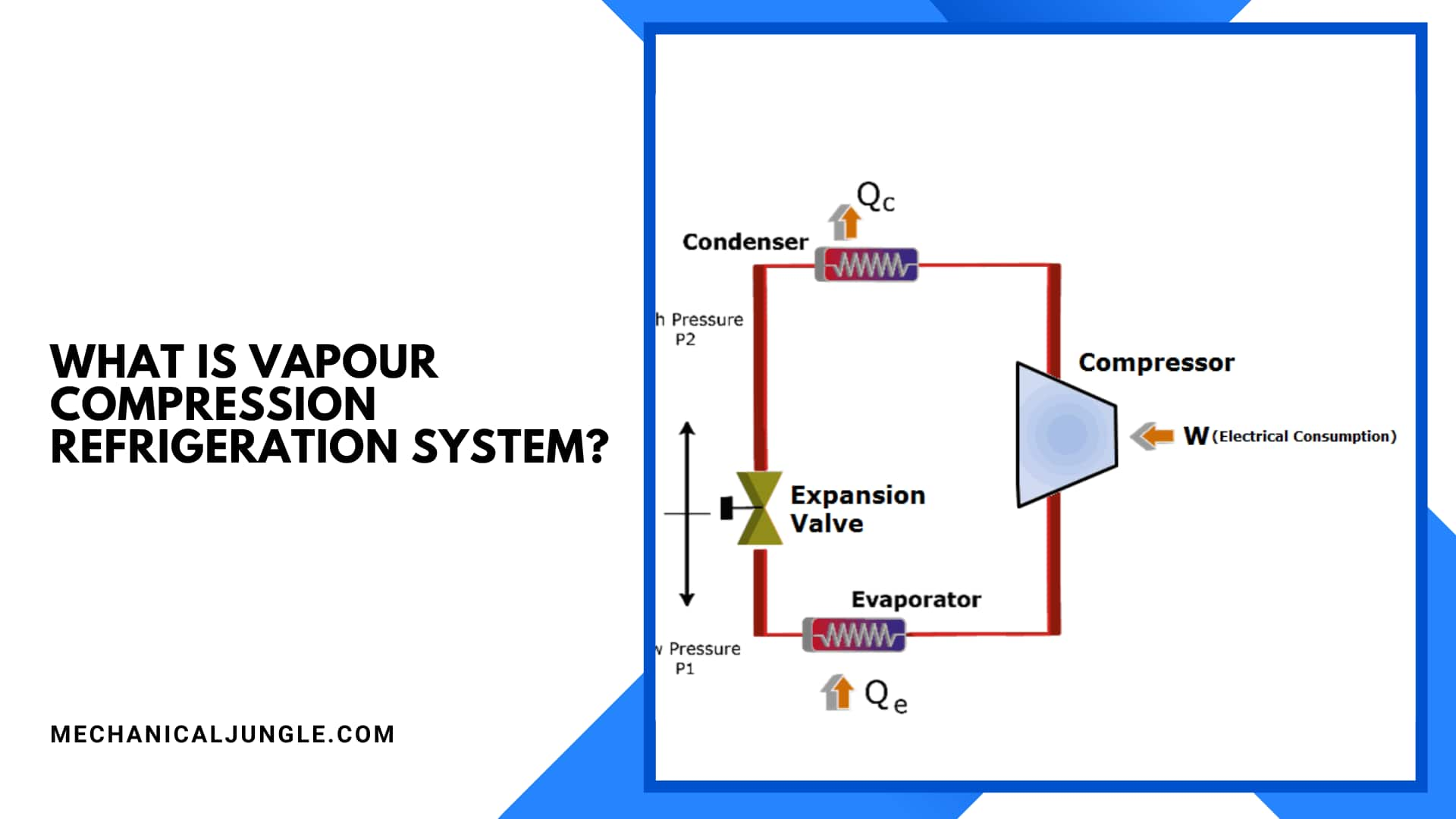
What Is Vapour Compression Refrigeration System?
This process is designated as a Vapour compression refrigeration system because the vapor in this system is compressed to produce vapor. The Vapour compression refrigeration systems ate the most commonly used refrigeration system among all refrigeration systems.
In this system, the phase of the working fluid changes twice from liquid to Vapour and again from Vapour to liquid. Refrigerant is achieved in this type of system because refrigerant evaporates at low temperatures providing cooling effects.
The actual Vapour compression cycles are based on the Evans – Perkins cycle, also known as the reverse Rankin cycle.
During evaporations, it absorbs heat from the cold body and is used as its latent heat to convert this heat from the liquid to vapor, while in condensing or cooling, it rejects heat to external bodies Gives, thus creating a cooling effect in the working fluid.
Components Used in Vapour Compression Refrigeration System:
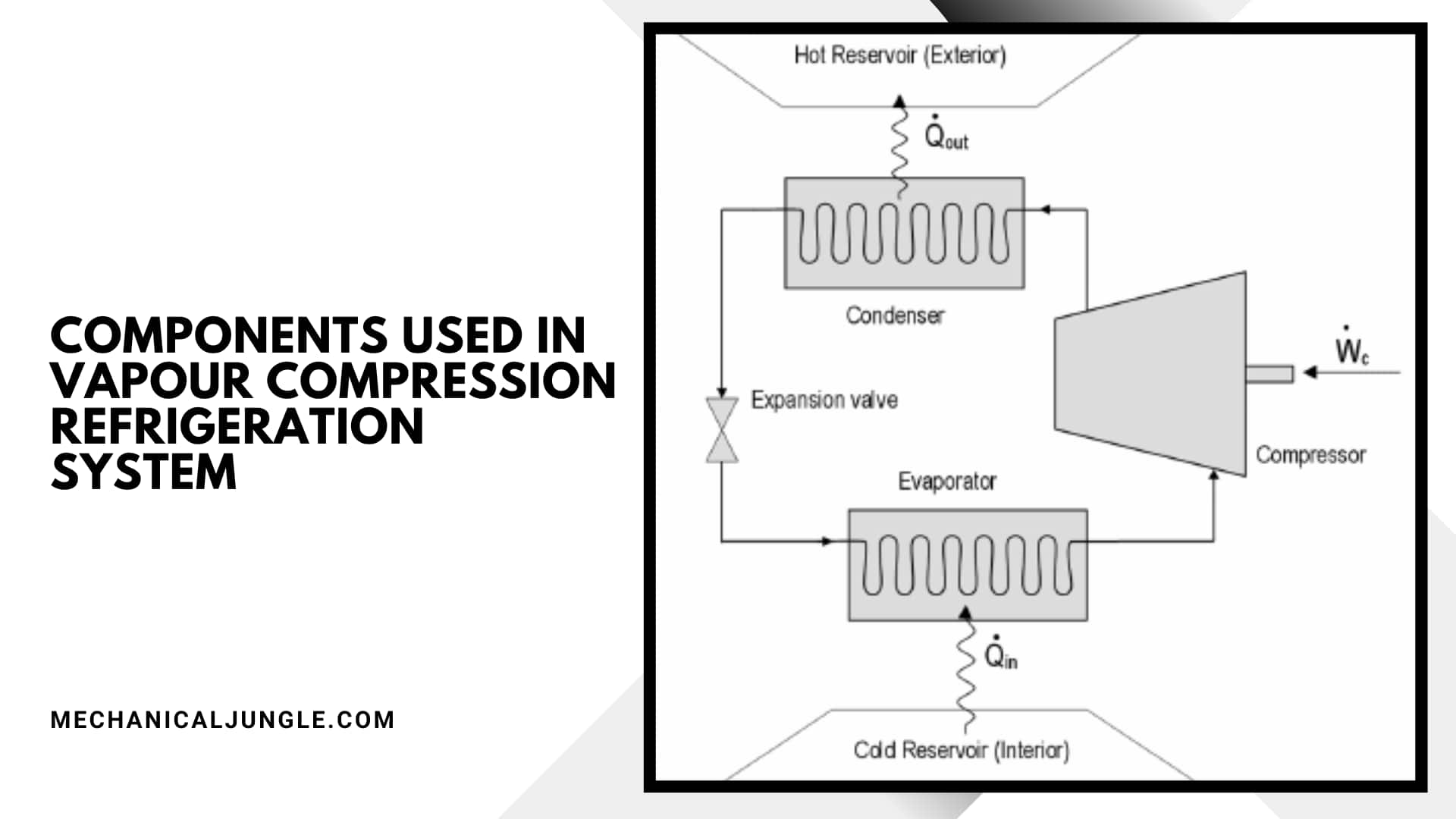
All components of the Vapour compression refrigeration system are connected via a pipe. The detailed explanation of the above parts is as follows.
#1. Compressor
At low pressures and low temperatures, the Vapour enters the compressor from the evaporator, where it is compressed at high pressures and high temperatures. This high pressure and temperature vapor refrigerant are discharged through the discharge valve into the condenser.
#2. Condenser
The condenser or cooler consists of pipe coils in which the high pressure and temperature Vapour refrigerant are cooled and condensed. When passing through the condenser, the refrigerant releases its latent heat to the surrounding condensing medium, usually air or water.
#3. Receiver
The condensed liquid refrigerant from the condensers is deposited in a vessel known as the receiver, from where it is supplied to the evaporators via an expansion valve.
#4. Expansion valve
It is also called a throttle valve. Its functions are to allow the liquid refrigerant to pass through high pressures and temperatures, where it reduces its temperature and pressure.
#5. Evaporator
It also includes pipe coils in which liquid-Vapour refrigerators are evaporated at low pressures and temperatures and converted to Vapour refrigerators at low pressures and temperatures.
Working of Vapour Compression Refrigeration System:
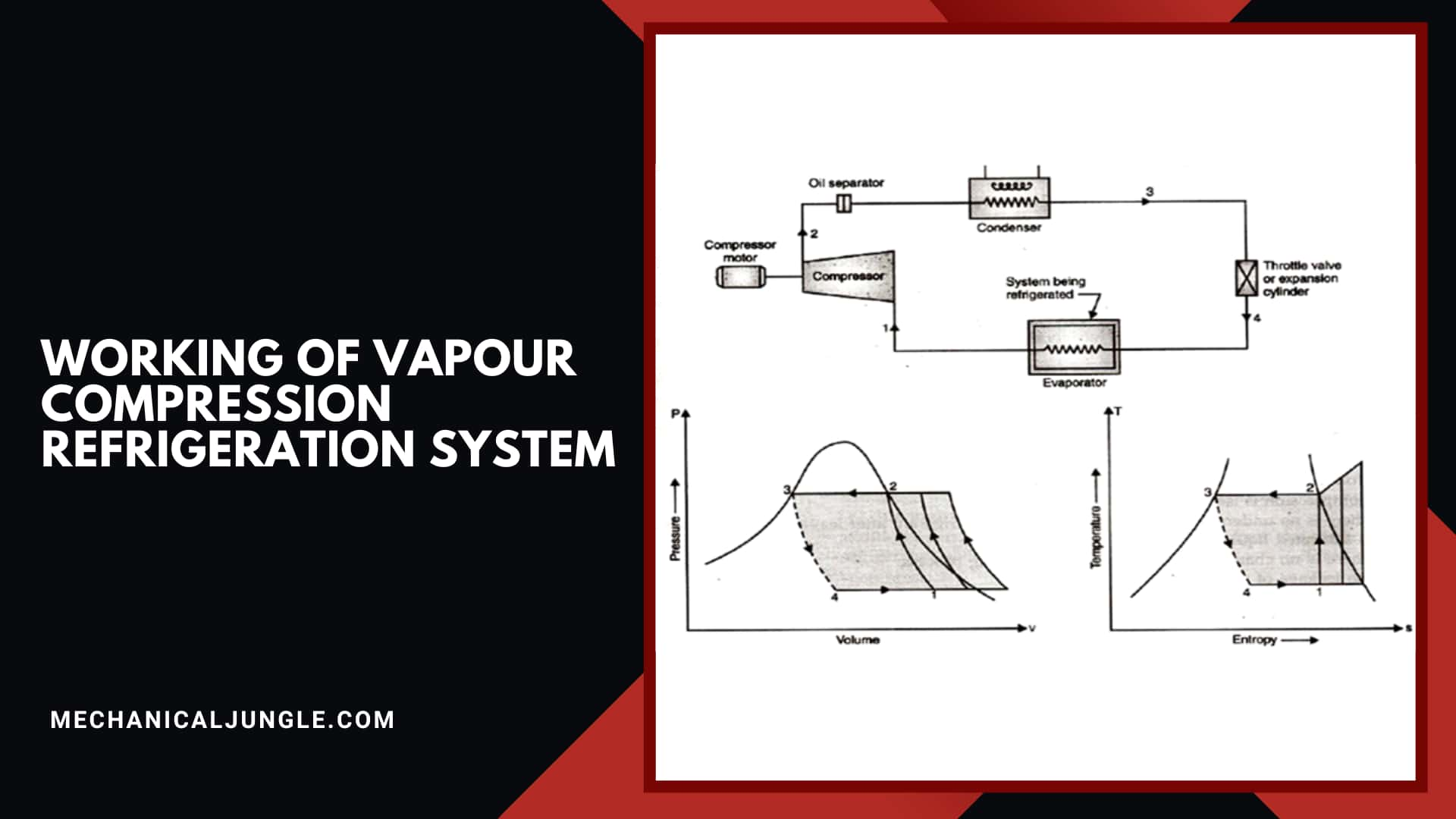
There are four steps involved in working of the Vapour compression refrigeration system:
#1. Compression (Reversible adiabatic compression)
In this compressor, high pressure and high-temperature superheated Vapour will be created by the compressor, & this superheated Vapour will be transferred to the condensers.
#2. Condensation (Constant pressure heat rejections)
In these condensers, the superheated Vapour will give its latent heat to the cooling fluid in the condensers. These cooling fluids can be air or water.
After entering the condensers, the superheated Vapour will be converted into a liquid as heats are extracted from the Vapour. These are called saturated liquids. After that, this liquid goes to expansion valves.
#3. Throttling And Expansion (Reversible adiabatic expansions)
In the expansion valve, the pressure & temperature of the saturated liquid will decrease. After that, this low temperature & pressure liquid will be transferred to the evaporator.
#4. Evaporation (Constant pressure heat additions)
In the evaporator, the low pressure & temperature liquid will be converted into Vapour. This liquid will takes all the heat from the evaporator & will get converted to Vapour using the heat taken from the evaporator. Hence, this liquid will decrease the temperatures inside the evaporators.
The fan present near the evaporators will supply warm air, & on another side, we will get cold air. After that, this Vapour will go to the compressor again, & this cyclic process will be repeated again and again.
Performance of Vapour Compression Refrigeration System:
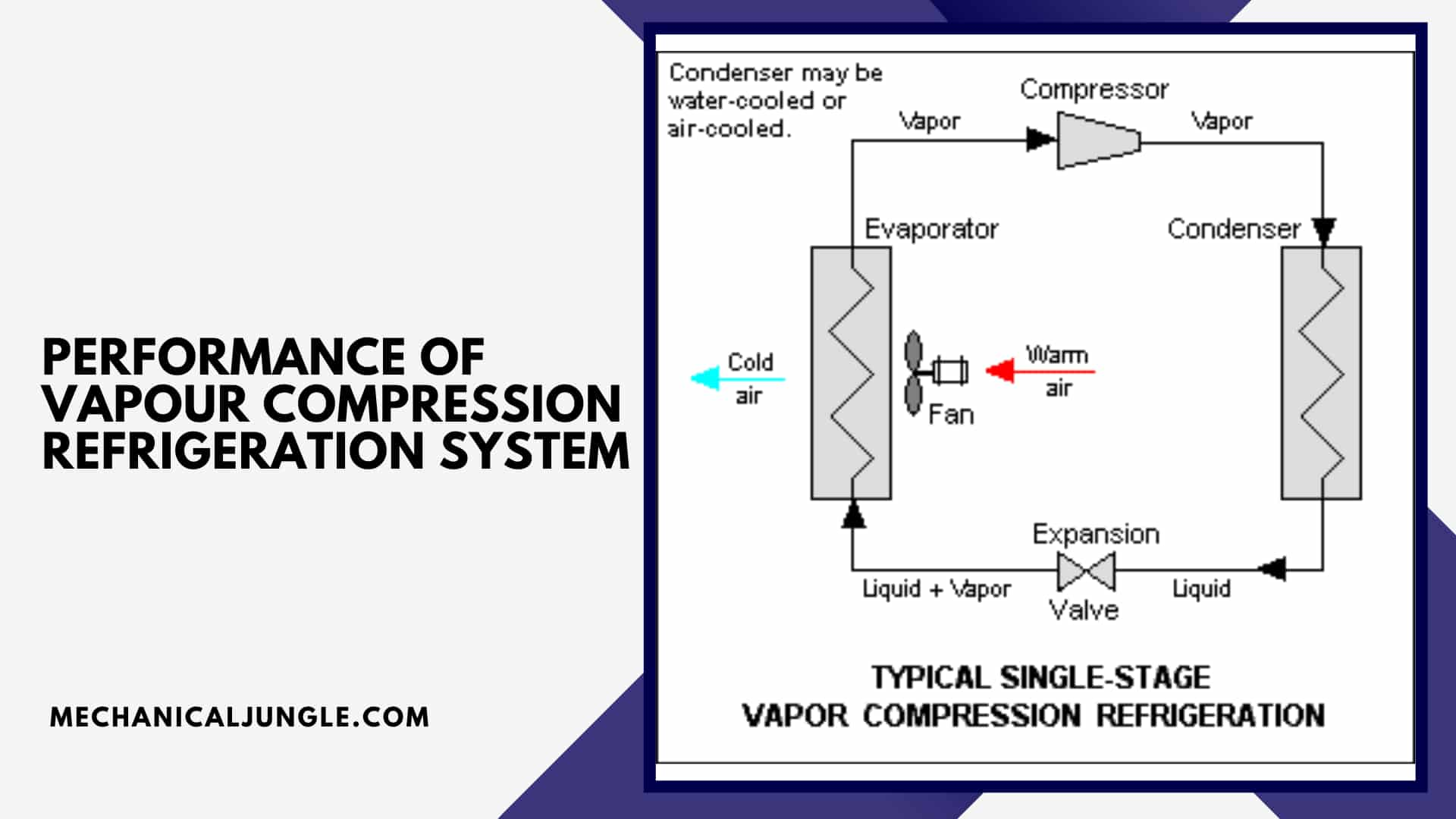
Applying Steady Flow Energy Equations (SFEE) at Evaporator, we get
h4 + Qe = h1 + 0
Qe = h1 – h4
Applying Steady Flow Energy Equations (SFEE) at Compressor, we get
h1 + 0 = h2 – W
W = h2 – h1
Applying Steady Flow Energy Equations (SFEE) at Condenser, we get
h2 – Qc = h3
Qc = h3 – h2
Applying Steady Flow Energy Equations (SFEE) at Expansion Valves, we get
h3 + Q = h4 + W
But we have Q=0 & W=0
So, h3 = h4
Co-efficients Of Performances
COP = Desired Effects / Work Input
= h1 – h4 / h2 – h1
Problems in the Vapour Compression Refrigeration System:
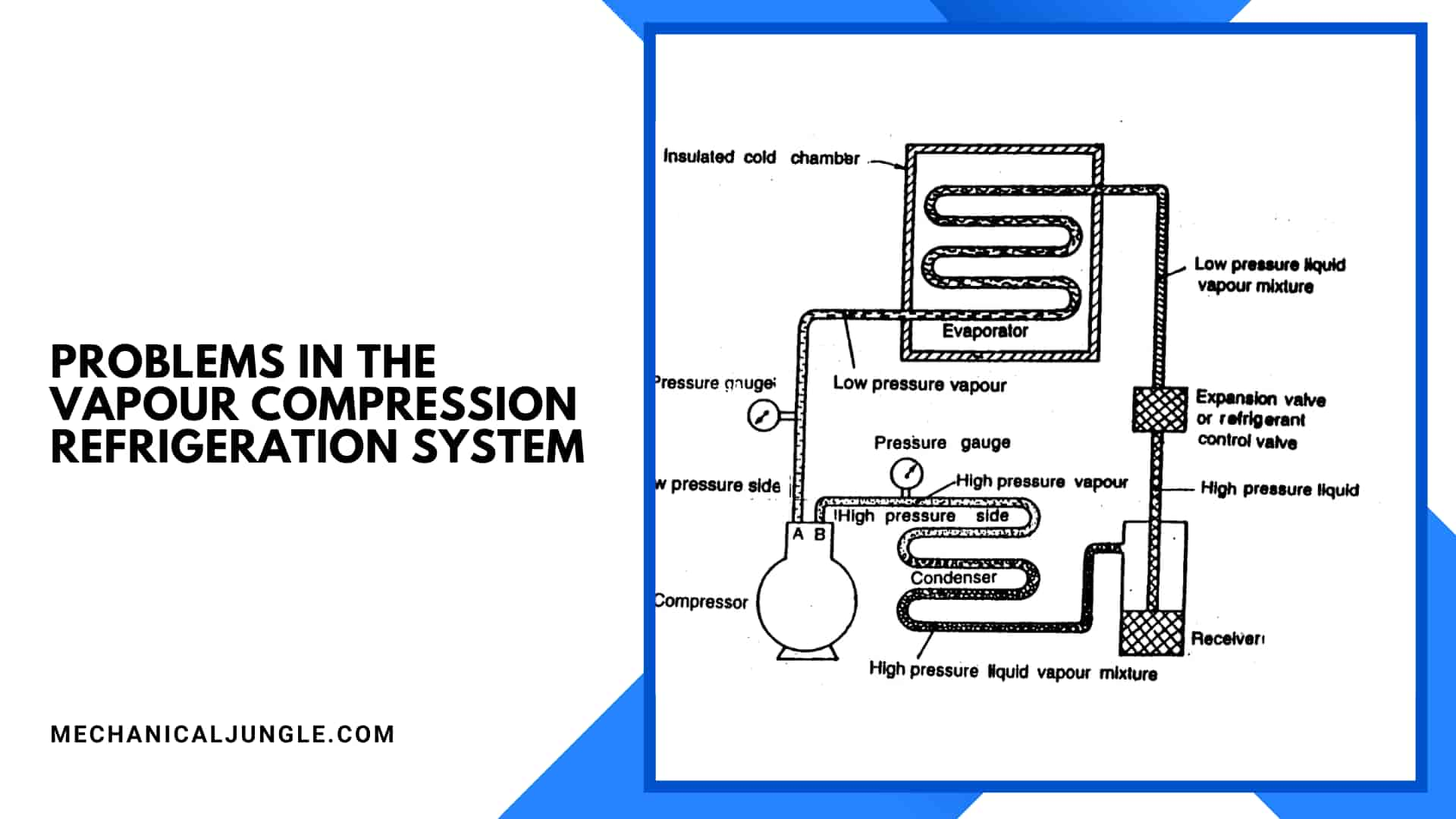
Some problems in a Vapour compression refrigeration system that may affect the efficiency of the system are:
#1. Compressor leakage/failure
Compressor leakage or failures are a major in vapor compression refrigeration systems. Compressor failure can cost the company too much if the compressor fails within the warranty period. It also affects the reputation of a company.
Some problems that can cause compressor failure are lubrication problems, slugging, overheating, and contamination.
#2. Fouling
Fouling is defined as the accumulations of unwanted deposited pipes of water and refrigerant transfer surface. The foulant layer imposes additional resistances to the flow of water or refrigerant.
Steps to Reduce Fouling:-
- Cleaning the evaporator’s surface frequently.
- Keeping the condenser tubes clean.
- Effective water treatments of the water used in the system should be done.
#3. Liquid Line Restriction
The restriction in the thermostatic expansion valves is called fluid line restriction. This problem can reduce the cooling capacity by up to 50%.
Causes of a liquid line Restriction:-
- Wax buildup in the valve due to incorrect oil use in the system.
- Too much oil in the system.
- Sludge formation due to compressor burning.
Symptoms of liquid line restriction: (How to know if the problem is due to liquid line restriction):-
- Very high discharge temperature.
- Low condensing pressure.
- Bubbles in the sight glass.
- Low current draw.
Test to know if the problem is a liquid line Restriction:-
- Temperature drop test.
- To do a freeze test.
- The problem can be easily pointed out using thermal imaging.
#4. Cooling problem
This is one of the most common problems in Vapour compression refrigeration systems. Due to this problem, the performance of the system decreases significantly.
Possible reasons for the cooling problem:-
- Dirty airways.
- Blocked air filter due to irregular cleaning.
Steps to prevent cooling problems:-
- Regular cleaning of air filters & air passages.
- A routine check of chiller logs, especially a comparison between amperage and voltage.
Types of Vapor Compression Cycles:

The types of Vapour Compression Cycles which are essential from the subject point of view are as follows.
- Cycle with superheated Vapour after compression.
- Cycle with superheated Vapour before compression.
- Cycle with wet Vapour after compression.
- Cycle with dry saturated Vapour after compression.
- Cycle with under cooling or subcooling of the refrigerant.
Advantages of Vapour Compression Refrigeration System:

The Advantages of the Vapour Compression Refrigeration system are as follows.
- The temperature at the evaporator sections can be controlled employing regulation of the expansion valve.
- It exhibits a high Coefficient of Performance.
- The running costs are low because the volume circulations of the refrigerant are low in the system.
Disadvantages of Vapour Compression Refrigeration System:
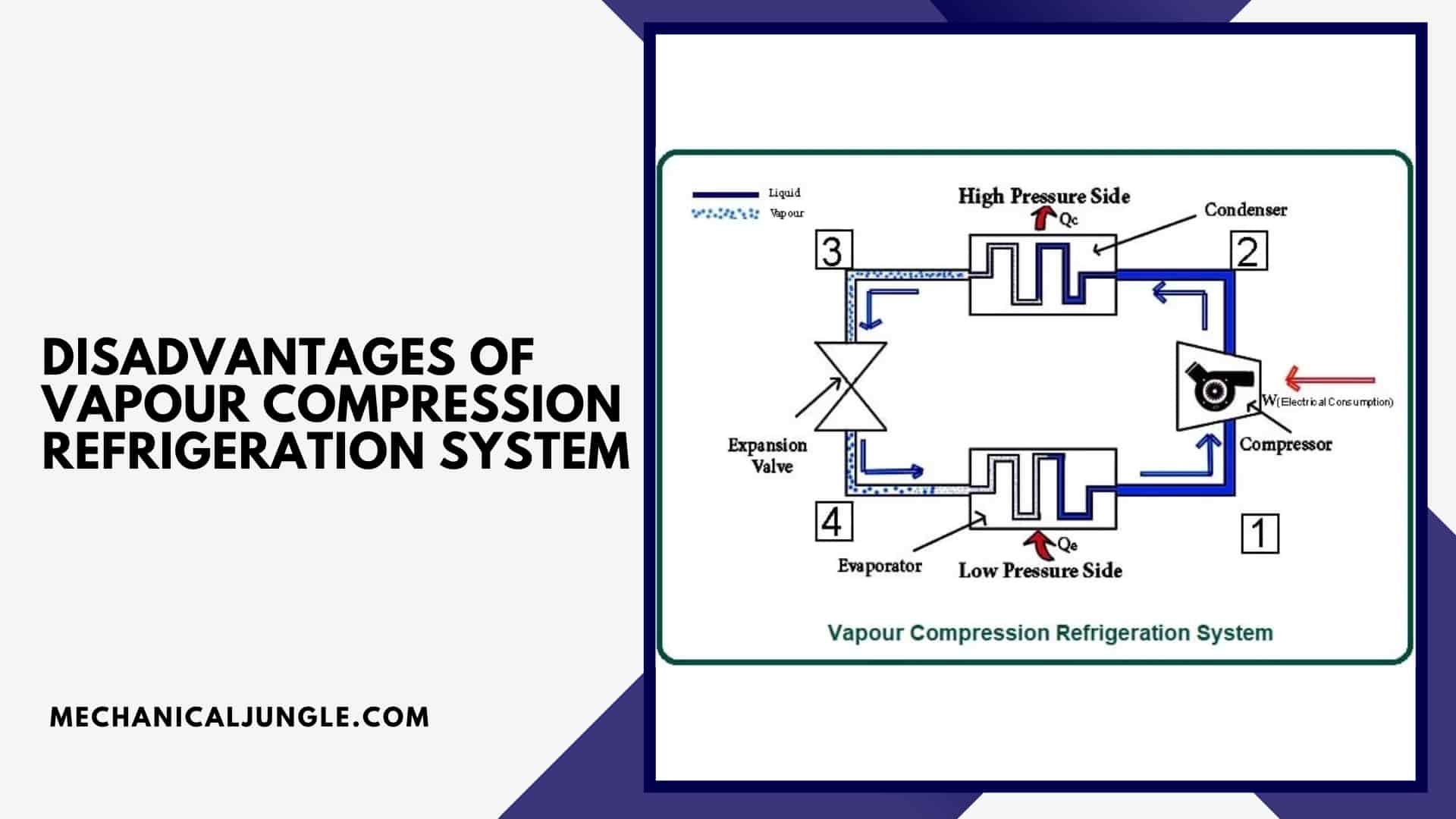
The disadvantages of the Vapour Compression Refrigeration system are as follows.
- Make sure that there should be no leakage of refrigerant from the pipes/hose.
- Refrigerants can affect the atmosphere.
- The cost of the system is high.
Applications of Vapour Compression Refrigeration System:
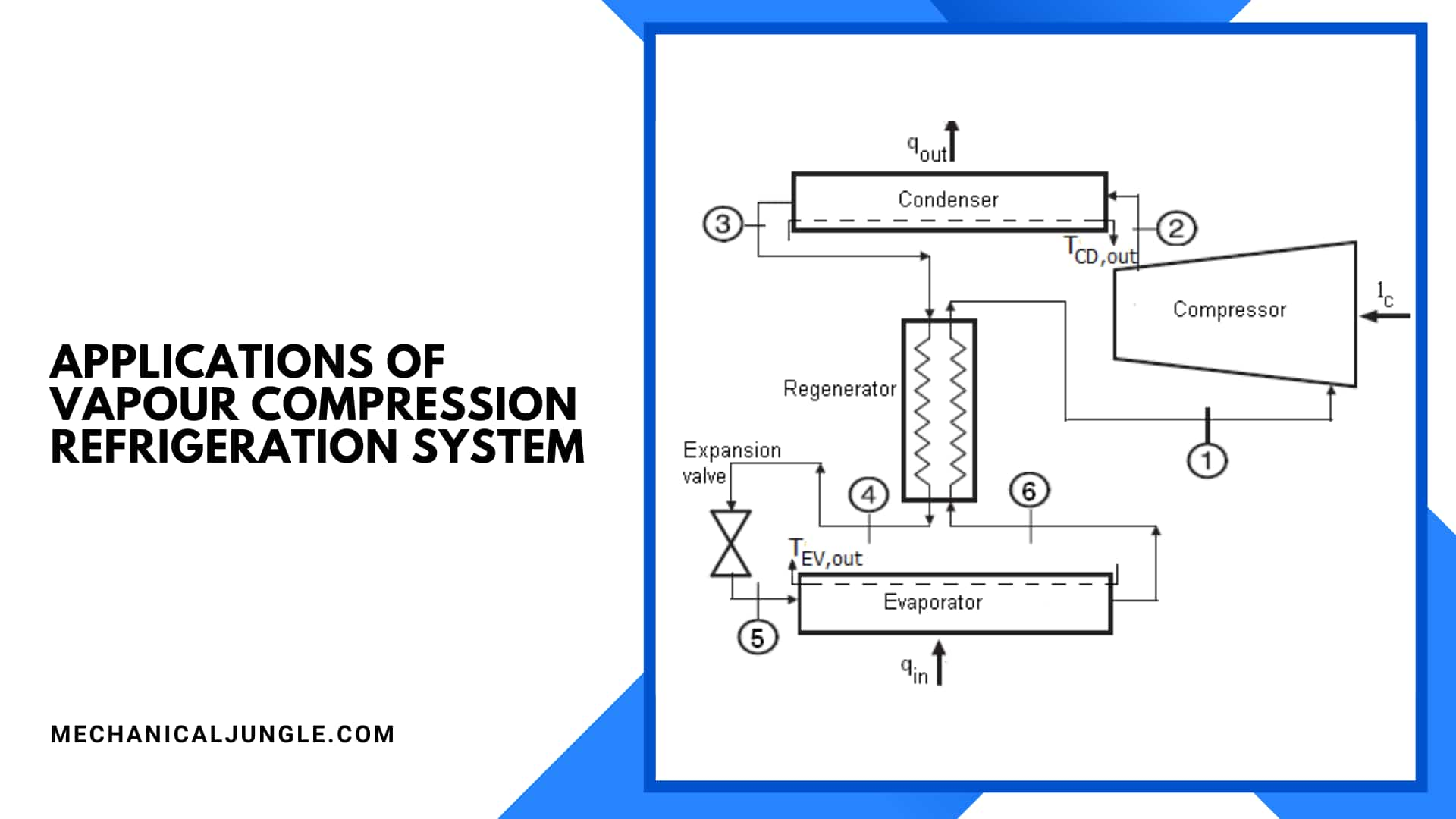
The applications of the Vapour Compression Refrigeration system are as follows.
- It is used in domestic refrigeration for keeping the food.
- It is helpful in food processing and cold storage.
- It is useful in Industrial refrigeration for chemical processing, heating, and cooling.
- It is useful in Cryogenic refrigeration, Medical refrigeration, Transport refrigeration, and Electronic cooling.
FAQ on Vapour Compression Refrigeration Systems
What Is a Vapour Compression Refrigeration System?
A Vapour Compression Refrigeration System is a type of refrigeration system where the refrigerant undergoes phase changes between liquid and vapor states to provide cooling. It is the most commonly used refrigeration system.
How Does a Vapour Compression Refrigeration System Work?
The system operates in a cycle involving four main stages: compression, condensation, throttling/expansion, and evaporation. The refrigerant absorbs heat from a low-temperature area during evaporation and releases it to a high-temperature area during condensation.
What Are the Main Components of a Vapour Compression Refrigeration System?
The main components include:
- Compressor: Compresses the refrigerant vapor to high pressure and temperature.
- Condenser: Cools and condenses the high-pressure vapor into a liquid.
- Receiver: Stores the condensed liquid refrigerant.
- Expansion Valve: Reduces the pressure and temperature of the refrigerant.
- Evaporator: Absorbs heat and converts the refrigerant back into vapor.
What Is the Role of the Compressor in the System?
The compressor increases the pressure and temperature of the refrigerant vapor, which then flows to the condenser for cooling and condensation.
How Does the Condenser Function in the Refrigeration Cycle?
The condenser removes heat from the high-pressure refrigerant vapor, causing it to condense into a high-pressure liquid.
What Does the Expansion Valve Do?
The expansion valve reduces the pressure and temperature of the liquid refrigerant before it enters the evaporator.
What Happens in the Evaporator?
The evaporator absorbs heat from the surrounding environment, causing the low-pressure liquid refrigerant to evaporate and cool the area.
What Is the Coefficient of Performance (Cop) of a Vapour Compression Refrigeration System?
The COP is a measure of the system’s efficiency, calculated as the ratio of the cooling effect to the work input. It is given by COP = (h1 – h4) / (h2 – h1), where h1, h2, h3, and h4 are the enthalpy values at different points in the cycle.
What Are Common Problems in Vapour Compression Refrigeration Systems?
Common problems include compressor leakage or failure, fouling, liquid line restriction, and cooling issues. These can affect the efficiency and performance of the system.
How Can Fouling in the System Be Reduced?
Fouling can be reduced by regularly cleaning the evaporator and condenser surfaces, using effective water treatments, and maintaining clean condenser tubes.
What Are the Types of Vapour Compression Cycles?
There are several types, including:
- Cycle with superheated vapor after compression.
- Cycle with superheated vapor before compression.
- Cycle with wet vapor after compression.
- Cycle with dry saturated vapor after compression.
- Cycle with under cooling or subcooling of the refrigerant.
What Are the Advantages of Vapour Compression Refrigeration Systems?
Advantages include high efficiency (high COP), controllable temperatures at the evaporator, and low running costs due to low refrigerant volume circulation.
What Are the Disadvantages of Vapour Compression Refrigeration Systems?
Disadvantages include potential refrigerant leakage, environmental impact of refrigerants, and high initial cost of the system.
Where Are Vapour Compression Refrigeration Systems Commonly Used?
These systems are used in domestic refrigeration, food processing, cold storage, industrial refrigeration for chemical processing, cryogenic refrigeration, medical refrigeration, transport refrigeration, and electronic cooling.
How Can Cooling Problems in the System Be Prevented?
Cooling problems can be prevented by regular cleaning of air filters and air passages, routine checks of chiller logs, and comparing amperage and voltage to ensure proper functioning.

